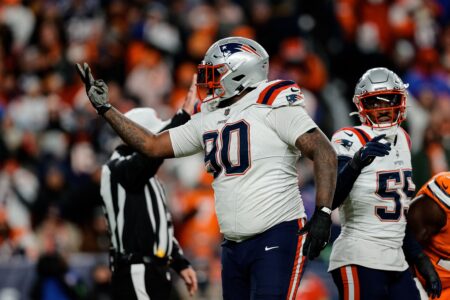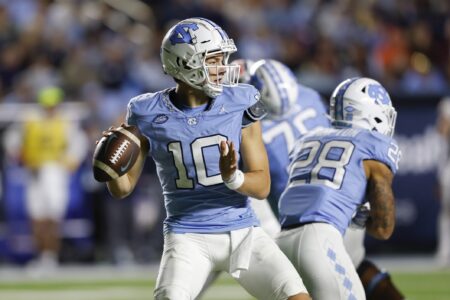deroc5050
In the Starting Line-Up
- Joined
- Jan 7, 2010
- Messages
- 2,636
- Reaction score
- 1,781
Registered Members experience this forum ad and noise-free.
CLICK HERE to Register for a free account and login for a smoother ad-free experience. It's easy, and only takes a few moments.Can you not read what you just typed? Why in the hell would the Colts balls be filled with 22 degrees colder air? You think the Colts balls were pumped up outside? Omfg
They don't have to be pumped up outside. What matters is not the air temp at pump up but at pressure reading. Air in a leather bladder is INSULATED. IT TAKE A WHILE FOR IT TO REACH OUTSIDE TEMPERATURE. The Colts balls were probably pumped up in indy for the most part. They were transported by bus in the storage area and thus COLD. THUS when pressure tested the air inside was cold.Can you not read what you just typed? Why in the hell would the Colts balls be filled with 22 degrees colder air? You think the Colts balls were pumped up outside? Omfg
I guess you should write the national science board or whatever. The Colts balls didn't lose as much pressure therefore the ideal gas law is wrong. It's been used for hundreds of years but based on that info alone it's wrong.
Omfg.
He's assuming the Colts balls didn't go down as much. I've read that too but it's not official.Are you really this dim? Patriots balls are done at the Patriots facility. Colts balls come from Indy in a bus, truck whatever where they would have colder air. Also the NFL has never stated the Colts balls were tested mid game. Show where the NFL said this.
How much does the football WEIGH not PSI when fully inflated. Like 14-15 oz so if you take 16% of the air out of the football does it way like .1 oz less. I know weight is not the issue but I am just curious.
espn sports science said if you deflate by 2psi, the weight loss is like 1.5 grams or the weight of a dollar bill
That may or may not be true, it depends on how that pressure decrease occurs.
Ideal gas law: PV=nRT. The weight is proportional to the mass of the air which is proportional to the number of moles of the air (n). If the volume V of the football is kept constant (a good approximation), there are two ways to reduce P:
The first way is to let air out of the football. In that case, n decreases, and thus the mass decreases (that must be what they mean by the 1.5 g mass decrease), and the weight would, in fact, decrease.
However, if P decreases because of a temperature drop only, there is no change in "n" and thus there would be NO decrease in the mass and weight of the air.
Of course, the football could "seem" heavier at lower temperatures because it would become less pliant (and thus might travel less on kickoffs). The weight could also actually change in fact if it gets wet (adding the weight of the water).
Valid points you bring up.
The video deflated the ball (which is what NE is accused of), no change in temperature. So they weighed the football before/after deflation which came up with 1.5g difference
There have been several people on this thread talk about what is or is not possible "according to the laws of physics", but there has been some confusion about what is, in fact, possible. It is true that according to the ideal gas law P1/P2 is proportional to T1/T2, but temperature must be in degrees kelvin and pressure should be absolute pressure, not gauge pressure (12.5 psi is gauge pressure). I happen to be a Physics Professor but rather than write a gigantic E-Mail here, let me refer to the link below which quotes Martin Schmaltz at BU, the article is, IMHO, accurate and succinct. The key issue is whether the balls were inflated indoors (at indoor temperatures) or outdoors (at outdoor temperatures), and where the pressure was subsequently measured. For the balls to have been deflated by 1.6- 2.0 psi in the cold weather (which evidently is only rumored), they would have had to be inflated at about 82 degrees F. So: a 1.6-2.0 psi deflation is, in fact, possible under the right circumstances. I hope the link clarifies things.
http://www.boston.com/sports/footba...ut-the-ball/Eocm5m29nIlh0HRBjFWsYO/story.html
How much does the football WEIGH not PSI when fully inflated. Like 14-15 oz so if you take 16% of the air out of the football does it way like .1 oz less. I know weight is not the issue but I am just curious.
Sports Science answered this question - a difference of 2 psi results in a weight difference less than a 1 dollar bill. The weight of the rain that day affected the football's weight and performance more than the internal PSI.
That's a whole lot of speculating on how Indy got their balls inflated . Like I said in my first post, until we know the evidence of the Colts balls, this is all null and voidThey don't have to be pumped up outside. What matters is not the air temp at pump up but at pressure reading. Air in a leather bladder is INSULATED. IT TAKE A WHILE FOR IT TO REACH OUTSIDE TEMPERATURE. The Colts balls were probably pumped up in indy for the most part. They were transported by bus in the storage area and thus COLD. THUS when pressure tested the air inside was cold.
Omfg indeed.
The ideal gas law is irrefutable. Get that? If Indys balls didn't go down much then they were colder to begin with. The fact they didn't go down as much is proof of that. The ideal gas law is not debateable. It's like saying gravity is debateable.
About 1 gram or the weight of one piece of a torn in half of a dollar bill. It ain't much and likely not discernible to ordinary humans.How much does the football WEIGH not PSI when fully inflated. Like 14-15 oz so if you take 16% of the air out of the football does it way like .1 oz less. I know weight is not the issue but I am just curious.
About 1 gram or the weight of one piece of a torn in half of a dollar bill. It ain't much and likely not discernible to ordinary humans.
The ideal gas law is a law of physics. It's not null and void. I don't have to know anything about how indy inflated (it actually doesn't matter at all just the temperature at initial pressure reading anyway).That's a whole lot of speculating on how Indy got their balls inflated . Like I said in my first post, until we know the evidence of the Colts balls, this is all null and void
The ideal gas law is a law of physics. It's not null and void. I don't have to know anything about how indy inflated (it actually doesn't matter at all just the temperature at initial pressure reading anyway).
No matter what indy did the ideal gas law says the pats balls go down 1.5psi if their temp goes from 72 to 45. That's just a cold hard fact of physics. Not a maybe or might Or a theory but fact.
No matter what indy did it doesn't change that. The law has already been proven.













